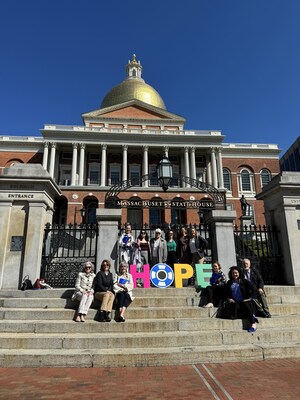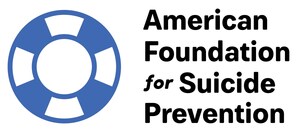NEW YORK, Feb. 15, 2023 /PRNewswire/ -- The Centers for Disease Control (CDC) released their Youth Risk Behaviors Survey for 2021, which provides insight into the health behavior and experiences of high school students across the United States. According to the 17,000 students surveyed in fall 2021, while several areas of adolescent health and well-being are continuing to improve overall, there were still experiences of violence, poor mental health, and suicidal thoughts and behaviors among certain subsets of students that are concerning. Youth have been traversing very difficult times heightened by the pandemic. The Adverse Behaviors and Experiences Survey (ABES) 2021 demonstrated that youth are experiencing stressors such as emotional and physical abuse, housing insecurity, fear of parental job loss, and hunger. These factors are likely to impact the responses provided by youth in this YRBS survey.
The American Foundation for Suicide Prevention (AFSP), the nation's largest suicide prevention organization, released the following statement regarding the CDC's data:
Given the recent findings from the CDC, AFSP acknowledges that there is significant work to be done in preventing suicide among youth and is committed to these efforts. We want to remind media and readers to be mindful of the nuances of the survey findings and take into consideration the following when interpreting this data:
- The data don't provide the full breakdown of exposure and experience by race, ethnicity, gender, sexual orientation yet and do not take into account the intersectionality across categories (e.g., females who are lesbian and nonbinary within and across race). Once we have the comprehensive breakdown, we'll have a clearer view of what communities need the most support and how these experiences affect populations differently. It's essential to understand the variations between the subsets of students so that we focus our efforts where they're needed most.
- The report points to a few different areas of improvement and progress. For instance, in 2021, 15% of high school students report that they were bullied versus the 20% of students that were bullied the year prior. Also, the number of high school students who were electronically bullied did not increase from 2020 to 2021.
- Ten percent of students attempted suicide in 2021. Even one death from suicide is one too many but we also want to avoid making young adults feeling overwhelmed by the misconception that everyone feels suicidal; fortunately, most people who think about suicide or make an attempt will not die by suicide.
- The mental health of female youth shows concerning trends. While more analysis is needed across subsets, trends are worsening for females. In 2021 30% of females seriously considered attempting suicide—up nearly 60% from a decade ago and 57% felt persistently sad or hopeless—double that of boys. This is the highest increase, nearly 60%, over the past decade. Nearly 20% of girls experienced sexual violence (up 20% since measurement started in 2017) and 15% report being forced to have sex (up 27% since measurement started in 2019).
- LGBQ+ youth are more likely to experience all forms of violence; differences in mental health compared to peers are substantial. We reiterate that more analysis is needed to understand subset impact, however the trends are concerning. Nearly 70% of LGBQ+ students experienced persistent feelings of sadness or hopelessness during the past year. Almost 22% attempted suicide during the past year and 45% seriously considering attempting suicide.
- The data do not paint the full picture of why certain subsets of students are seeing high levels of suicide risk. Suicide is complex, risk is dynamic, and an individual's personal risk factors combined with precipitants such as experiences with isolation, depression, anxiety, economic stress, suicidal ideation, and access to lethal means may lead to periods of increased risk.
This data are an important reminder that we cannot slow down in our efforts to stop suicide and improve mental health among youth and teens. It is imperative that we continue working to create safe, healthy environments for this population to have open, honest conversations about suicide and mental health. We must educate everybody – students, parents, teachers, counselors, communities – how to manage mental health and how to seek help for someone you're concerned about or yourself. We strongly encourage parents, teachers, community leaders and health professionals to review and share resources to help ignite these much-needed efforts, including:
- AFSP's tips for what to do when someone is at risk for suicide.
- The importance of school in fostering sound youth mental health cannot be overstated. There is a strong correlation between students who feel more connected in school environments and their academic performance and mental health. Building schools' capacity to support student mental health is imperative. According to the American College Counseling Association, less than 20% of students who died by suicide used their school's counseling center as a resource. AFSP has a multitude of school resources for students, parents and administrators to build positive mental health in school communities.
- In partnership with The JED Foundation and the Ad Council, AFSP's Seize the Awkward campaign "We Can Talk About It" encourages young people to push past pervasive taboos, misconceptions and stigmas about mental health by seizing the awkward and reaching out to a friend. The campaign features a PSA and guidance for teens and young adults on how to have these conversations.
- Talk Saves Lives: Talk Saves Lives is AFSP's standardized, 45-60 minute education program that provides participants with a clear understanding of this leading cause of death, including the most up-to-date research on suicide prevention, and what they can do in their communities to save lives. Participants will learn common risk factors and warning signs associated with suicide, and how to keep themselves and others safe. The standard Talk Saves Lives presentation is also available in Spanish.
- Blueprint for Youth Suicide Prevention: The American Academy of Pediatrics (AAP) and American Foundation for Suicide Prevention (AFSP), in collaboration with experts from the National Institute of Mental Health (NIMH), created this Blueprint for Youth Suicide Prevention as an educational resource to support pediatric health clinicians and other health professionals in identifying and advancing equitable youth suicide prevention strategies in all settings where youth live, learn, work, and spend time.
While we can't ignore the gravity of what these data indicate, we must not panic. We all have a responsibility to check in with others on their mental health, have honest conversations, and make a plan to help each other. If you see or hear something that makes you concerned for someone's safety, ask directly how they are doing. If you're a young adult, bring in an adult. If that adult doesn't listen, bring in another adult. We can help each other and we can make a difference.
Supporting student's mental health in schools is a priority of AFSP's advocacy and public policy efforts. For LGBTQ youth, we know that protective actions like increasing acceptance and affirmation of LGBTQ identities, reducing anti-LGBTQ stigma and prejudice, and increasing access to LGBTQ-affirming physical and mental health care reduce the likelihood of LGBTQ youth suicidality and promote wellbeing. We invite you to join our efforts in ensuring positive and affirming school environments for all students here.
For more resources on how to help youth and teens with mental health and suicide prevention, visit https://afsp.org/tag/youth.
We encourage media to consider these Safe Reporting Guidelines to minimize hopelessness and to increase help-seeking when covering this news and topics related to suicide.
The American Foundation for Suicide Prevention is dedicated to saving lives and bringing hope to those affected by suicide, including those who have experienced a loss. AFSP creates a culture that's smart about mental health through public education and community programs, develops suicide prevention through research and advocacy, and provides support for those affected by suicide. Led by CEO Robert Gebbia and headquartered in New York, with a public policy office in Washington, DC, AFSP has local chapters in all 50 states including Puerto Rico, with programs and events nationwide. Learn more about AFSP in its latest Annual Report, and join the conversation on suicide prevention by following AFSP on Facebook, Twitter, Instagram, and YouTube.
SOURCE American Foundation for Suicide Prevention

WANT YOUR COMPANY'S NEWS FEATURED ON PRNEWSWIRE.COM?
Newsrooms &
Influencers
Digital Media
Outlets
Journalists
Opted In






Share this article